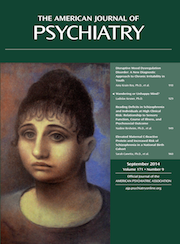The Structure of Psychiatric Science
Abstract
This essay addresses two interrelated questions: What is the structure of current psychiatric science and what should its goals be? The author analyzed all studies addressing the etiology of psychiatric disorders in the first four 2013 issues of 12 psychiatry and psychology journals. He classified the resulting 197 articles by the risk factors examined using five biological, four psychological, and three environmental levels. The risk factors were widely dispersed across levels, suggesting that our field is inherently multilevel and already practicing empirically based pluralism. However, over two-thirds of the studies had a within-level focus. Two cross-level patterns emerged between 1) systems neuroscience and neuropsychology and 2) molecular or latent genetic factors and environmental risks. The author suggests three fundamental goals for etiological psychiatric research. The first is an eclectic effort to clarify risk factors regardless of level, including those assessed using imaginative understanding, with careful attention to causal inference. An interventionist framework focusing on isolating causal effects is recommended for this effort. The second goal is to clarify mechanisms of illness that will require tracing causal pathways across levels downward to biological neuroscience and upward to social factors, thereby elucidating the important cross-level interactions. Here the philosophy of biology literature on mechanisms can be a useful guide. Third, we have to trace the effects of these causal pathways back up into the mental realm, moving from the Jasperian level of explanation to that of understanding. This final effort will help us expand our empathic abilities to better understand how symptoms are experienced in the minds of our patients.



